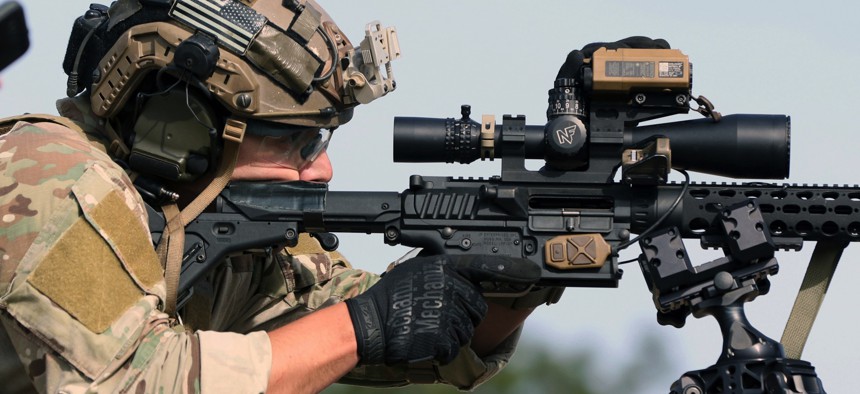
A competitor in the United States Army Special Operations Command International Sniper Competition uses a digital range finder on his weapon while engaging long-distance targets at Fort Bragg, North Carolina, March 19, 2019. U.S. Army / K. Kassens
Army Mulls 10-20% Cut to Special Operations Forces
Lawmakers and Army officials have discussed cuts through decade’s end, including to Green Berets, psyops, and enablers.
The U.S. Army is considering cutting 10 to 20 percent of their special operation forces, according to Capitol Hill officials and a former top commander of the service’s elite forces.
Kenneth Tovo, a retired Army lieutenant general who led U.S. Army Special Operations Command, was asked by Sen. Ted Budd, R-N.C., at a Senate hearing on Wednesday about “the administration's plans to cut 10 percent of U.S. Army Special Operations Forces” and their likely effect on the service’s ability “to provide combatant commanders with options for great power competition, counterterrorism and crisis response.”
“I think it'll be crippling,” said Tovo, who was speaking before the Armed Services subcommittee on emerging threats and capabilities. “10 percent of the force is going to be a significant—…the higher end is even 20 percent.”
Later, a congressional aide went into more detail.
“I’m told by both mid- and senior-level officials in the Army and special operations that cuts to [special operations forces] are coming. Cuts of at least 10 percent. I say again: at least 10 percent are currently reflected in TAA 25-29. TAA is Total Army Analysis 25-29, which is the Army’s process by which they determine future force structure and inform the budget process,” said the aide, who spoke on condition of anonymity to discuss the cuts.
"I’m told that the cuts will be most acute on SOF enablers like logistics and intelligence, but that some changes to force structure are also likely for Special Forces, civil affairs, psychological operations," the aide said.
A second congressional aide confirmed that Army officials were talking with lawmakers and staffers about such cuts but did not say just how deep they might be.
An Army spokesperson, asked about the potential cuts, referred questions to U.S. Special Operations Command.
Kenneth McGraw, a spokesman for U.S. SOCOM, said, “It would be inappropriate for us to speculate on what future decisions might be made about special operations force structure.”
Last week, Gen. Bryan Fenton, commanding general of U.S. Special Operations Command argued in a op-ed in Defense One that the nation’s elite forces that proved to be so valuable for recent counterterrorism wars would be just as necessary for future conflicts and deterrence, saying the United States must “strengthen our ability to contribute to the United States’ contest with great-power adversaries.”
The first aide argued Army proposals to cut end strength are understandable.
“There are very real constraints being placed on the Army, and we understand that, both budgetary and due to the recruiting crisis,” he said. “And changes to force structure are needed both to address those impacts to the overall end strength of the Army and to ensure that the Army can compete with China and Russia, and fight and win America’s wars. But I think we would all prefer that our adversaries are deterred rather than resorting to armed conflict. And competition is happening every day in the grey zone, and that work is primarily being done by special operators who are enabled by both cyber and space capabilities.”
Both staffers said that the Army has not officially told Congress about their end-strength proposals.
“The bottom line is that SOF requirements are increasing, so any loss of capability or capacities for our special operations forces is going to be met with extreme skepticism by members of Congress on both sides of the aisle,” the first aide said.
Sen. Joni Ernst, R-Iowa, said at the hearing, “You cannot mass-produce [special operations forces] in a crisis. And we can't get to a point where we're faced with a crisis and we do not have the operators that are able to step forward. So, we really do have to push back against that.”
Tovo said cuts in intelligence enablers would be “devastating.”
“We're a force that is very much driven by our intelligence community,” he said. “And if the cuts are taken there—and that's one of the places that the service I believe wants to take the cuts—that will be devastating. Without the intelligence capability, our operational capability is hobbled at best.”
He also said cuts are likely to affect troops in the Green Berets, psychological operations, and civil affairs, which are “areas where we really can't afford—they are the prime forces for competition.”
“They are the persistent present forces out in the crisis spots of the world who are working with partners and have the ability to do all the things that our last two [National Defense Strategies] have said we want to be able to do to leverage partners and allies,” he said. “And if we take cuts in those, we'll certainly have less capability.”
Once cuts are made, the time it would take to rebuild those forces again is “hard to say, but it'll be measured in years,” Tovo told the senators.
Demand for operators is not waning, and if anything, people in specific specialties are more in demand than what the military currently has. Jonathan Schroden, the research program director for Countering Threats and Challenges at the Center for Naval Analyses, led a recent congressionally mandated force structure assessment that looked into what combatant commanders and the services were requesting for SOF compared to the current force structure.
“We ran a bunch of different calculations, scenarios, etc. One of the common themes in terms of force structure requirements that emerged from those is in almost every scenario we looked at, there was a higher demand for PSYOP forces, for civil affairs forces, for undersea warfare and maritime capabilities, than what the force has today,” Schroden said.




